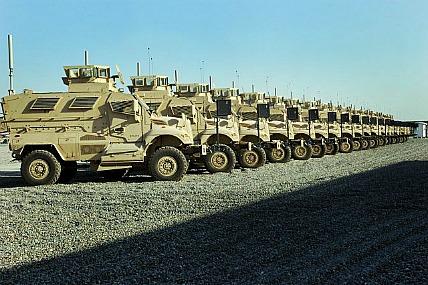The U.S. Army is in the process of refining a long-term plan for its fleet of 20,000 blast-deflecting, mine-resistant, ambush-protected vehicles, known as MRAPs, service officials explained.
Some of the MRAPS will be placed in brigade combat team configurations for as-needed troop transport and route clearance missions; some will be put in storage facilities and others will be kept for training purposes, according to Department of the Army G-8 officials.
"The MRAPs were a very successful program," said Col. Mark Barbosa, chief, Focused Logistics Division, Director of Material, G-8. "The $45-billion investment had Office of the Secretary of Defense, or OSD, oversight, with very strong support in Congress. The platform was rushed to theater to protect our Soldiers and it did very well. In order to meet the timelines we needed to meet, we had to go to multiple vendors and we had to go to very large quantities."
Now that the war in Iraq is over and plans for an Afghan drawdown are underway, the Army is outlining a long-term plan for the vehicles to place roughly 60 percent of them in storage or prepositioned stocks, 30 percent of them with units and about 10 percent of the fleet for home-based troop training. In addition, a small number will be divested, Barbosa said.
At the same time, the MRAP plans are a key part of the calculus of the Army's overall fleet strategy which, among the flagship program, plans to incrementally field the new, next-generation Joint Light Tactical Vehicle, or JLTV. The now-in-development JLTV, a new, high-tech light tactical vehicle to begin fielding by 2016, is being engineered with MRAP-like protection at a much lighter weight.
"The JLTV will bring the MRAP-level protection that we need, and the on-board power we will need for current and future networks. Also, the JLTV will have an off-road mobility and system reliability that will exceed what we have in MRAPs," said Tim Goddette, director of sustainment systems for the Office of the Assistant Secretary of the Army for Acquisition, Logistics and Technology, or ASA(ALT).
Overall, MRAPs only represent about seven percent of the Army's wheeled vehicle inventory; by contrast, the Army plans to have JLTVs make up roughly one-quarter of its total tactical wheeled vehicle fleet, officials said. In essence, the Army plans to acquire as many as 50,000 JLTVs by 2035, they said.
The JLTV, which has finished up its Technology Development phase aimed at refining requirements, is now poised to enter the Engineering and Manufacturing Development phase of the program. It is being built with an unprecedented blend of protection, payload capability and performance for a light tactical vehicle, officials said.
"Even after the war, MRAPs are going to continue to play an important role as an interim capability for the next ten years until JLTV comes on line in sufficient quantities," Goddette said.
Goddette also explained that the reset and sustainment process for the current MRAP fleet will involve ongoing work at Army depots such as the Red River Depot, Texas, and Letterkenny Depot, Pa., aimed at bringing more of the vehicles into a common configuration.
"When we reset the vehicles, we want to use the opportunity to bring the vehicles into a common configuration; this will help us get more efficient with sustainment and training," Goddette said.



























